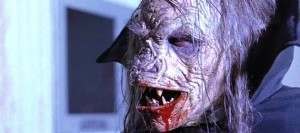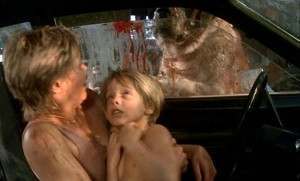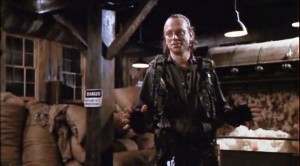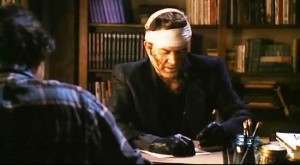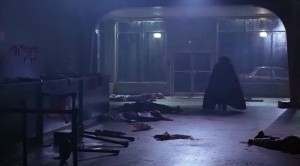HOLLYWOOD filmmakers have been adapting the literary works of horror maestro Stephen King since 1976, and often with tremendous financial and critical success.
De Palma’s Carrie (1976), Kubrick’s The Shining (1980), Romero’s Creepshow (1982) and Cronenberg’s The Dead Zone (1983) are just a few memorable titles from the first wave of silver screen adaptations, but other, later successes include Misery (1990) and The Mist (2008).
Boasting a canon that includes over fifty films at this point, it’s only natural that some efforts should be forgotten or not quite given their due as works of art.
That idea in mind, below are listed, in chronological order, five of the most underrated films based on the genre works of Stephen King.
Cujo (1983)
King himself is an ardent defender of this cinematic adaptation of his literary best-seller about a rabid dog attacking a mother and her son, and for all the right reasons. King has rightfully noted that the 1983 Lewis Teague film is relentless, and that it just keeps pounding the viewer with one harrowing scene of violence after another.
The movie version of Cujo settles down in one central location (a parked car…), and pits its two likable stars — Dee Wallace and Danny Pintauro — against a truly awful, vicious and yet tragic adversary: a sick St. Bernard. Accordingly, Teague utilizes every expressionistic film trick in the book, up to and including the dog’s P.O.V. to escalate the terror to throat-tightening levels.
On top of its technical prowess, Cujo seems a crucial part of the mid-1980s “motherhood’s resurgence” cinematic movement in horror films that also included The Terminator (1984) and Aliens (1986). In short, Cujo is spare horror film-making that gets the job done: it scares the hell out of you
Creepshow 2 (1987)
Critics didn’t have much positive to say regarding this sequel to the 1982 George Romero hit anthology, and on the surface, the sequel certainly looks like a cut-rate knock-off. Creepshow 2 features only three stories, not five, and the wraparound narrative device for the anthology involves some lame and fairly life-less animation.
But where it counts, Creepshow 2 delivers the good, at least in terms of its last two tales. “The Raft” is a mini-masterpiece in which four callow teens are menaced, on the first day of winter, by the unexpected appearance of a blob-like amoeba at an isolated lake.
The story proves unfailingly tense as the teens realize that they can neither out-swim nor out-wait their adversary at the lake, and the segment’s final, unforgettable image is a wicked joke of sorts. There’s simply no Hollywood bullshit about this entry, and that fact also makes it refreshing. Very quickly, the teens descend into amorality and resort even to personal sabotage to assure that they — and not their friends – survive the day.
The film’s third segment, “The Hitchhiker” stars Lois Chiles as Annie, a woman attempting to get back home after a sexual dalliance late at night. Not watching where she is driving, she runs over a hitchhiker, and is consequently haunted by him as his gory but ambulatory corpse keeps re-appearing and keeps saying — to audience howls of delight — “thanks for the ride, lady!” This unexpectedly effective story hits the horror sweet-spot, proving funny, gory and scary at the same time. “The Hitchhiker” also serves as a kind of fun catharsis after the straight-up existential terror of “The Raft.”
Graveyard Shift (1990)
A low-budget production featuring some pretty bad special effects, Graveyard Shift concerns a textile mill where the working conditions are not exactly OSHA-approved.
Indeed, that’s the point, since Graveyard Shift arrived in the theaters in the early 1990s, just after the systematic dismantling of American labor by the laissez-faire policies of the Reagan Administration and immediately before NAFTA caused Ross Perot’s giant “sucking sound” (of American jobs heading south of the border…) Here, an avaricious boss — a tyrant played by Stephen Macht — forces the powerless workers at hiss mill to toil in filthy conditions, and give up their weekend to do it to boot.
Unfortunately, the workers are also faced with a giant, hungry rat in the mill’s basement (which is conveniently connected to a graveyard…). Luckily, Brad Dourif shows up as a half-bonkers exterminator, and his twitchy, over-the-top performance adds an element of fun to the proceedings.
In addition to being a low-budget effort, Graveyard Shift is decidedly low-brow too, but it features some great narrative reversals and surprises in terms of who survives the day of the rat. More than that, the film feels like the (humorless) Office Space (1999) of horror movies: a film that reveals how a really bad boss can call the shots and ruin your day…or even your life.
The Dark Half (1993)
I featured this film recently in a list about underrated George A. Romero films, but it belongs here too. This film version of The Dark Half is a faithful adaptation of King’s novel, and captures the book’s key idea that the act of creation implies no control after “birth.”
Here, a writer, Thad Beaumont (Timothy Hutton) creates a dark nom de plum, George Stark that — once born – doesn’t limit himself to writing pulpy crime novels. Instead, when Thad seeks to retire him permanently, Stark fights for his very life, and violently so. In some ways Thad is a brother to Stark, and in some ways a parent too. But he has no control of his alter ego, as he soon discovers.
Romero doesn’t go for the easy or cheap thrills or de rigeuer jump scares and instead fashions a cerebral, deliberately-paced horror film that forecast the post-modern direction of the genre in the 1990s and films such as Wes Craven’s New Nightmare (1994), In the Mouth of Madness (1994), and Scream (1996).
The Night Flier (1997)
Award-winning horror film journalist John Bowen directed me to this Stephen King adaptation when I was writing Horror Films of the 1990s, and I’m glad he did.
Described bluntly, The Night Flier is sort of a Kolchak the Night Stalker story set in the latter-day world of tabloid journalism…and in a world in which Kolchak is an amoral a-hole, instead of an unconventional hero. But where Kolchak emerged in the post-Watergate Age of Woodward and Bernstein, the journalist here, named Dees (Miguel Ferrer) is more like Geraldo Rivera, post-Al Capone’s vault.
The Night Flier tells the story of Dees as he investigates the story of Dwight Renfield, a man — and possible vampire — who haunts small, out of the way airports.
The film was perfectly-timed to capitalize on a profession in transition and the rise of corporate-controlled media. It arrived smack-dab in the era of O.J. Simpson, Monica Lewinsky, and Tanya Harding. Accordingly, The Night Flier develops an interesting comparison between protagonist and antagonist. Both the vampire and Dees himself feed on spilled blood, on hurting people. If you believe the pen is mightier than the sword, you get the point: Dees harms others with his words, whereas the vampire is more direct in his ability to cause suffering. Of course, what Dees does — the journalism of personal destruction — makes the victim’s suffering last longer.
Cynical as Hell and sharply observed, The Night Flier is the Stephen King horror film that few saw, and is far better than its reputation indicates.
Would you like to support Flashbak?
Please consider making a donation to our site. We don't want to rely on ads to bring you the best of visual culture. You can also support us by signing up to our Mailing List. And you can also follow us on Facebook, Instagram and Twitter. For great art and culture delivered to your door, visit our shop.
